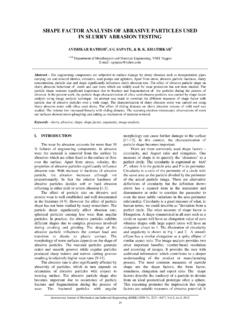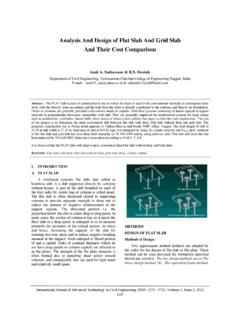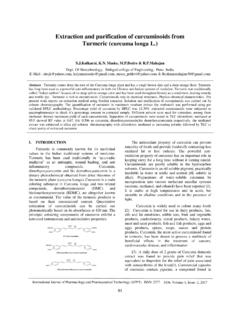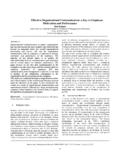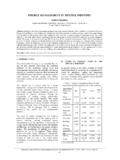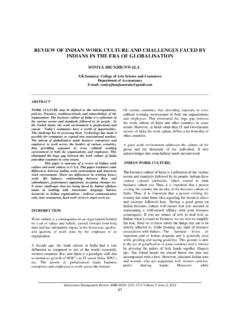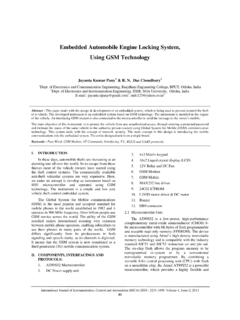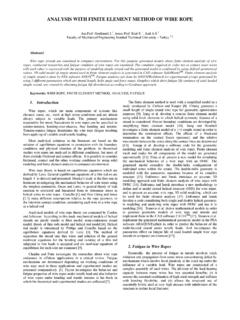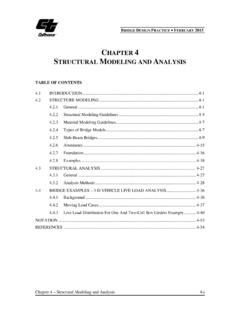Transcription of FINITE ELEMENT ANALYSIS OF PRESTRESSED …
1 International Journal of Advanced Technology in Civil Engineering, ISSN: 2231 5721, Volume-1, Issue-3,4, 2012 29 FINITE ELEMENT ANALYSIS OF PRESTRESSED concrete BEAMS ABHINAV S. KASAT1 & VALSSON VARGHESE2 1( Student (M-Tech- Structure), Department of Civil Engineering, KDKCE, Nagpur-440009, Maharashtra, India) 2(Professor, Department of Civil Engineering KDKCE, Nagpur-440009, Maharashtra, India) Abstract: concrete structural components exist in buildings and bridges in different forms. Understanding the response of these components during loading is crucial to the development of an overall efficient and safe methods have been utilized to study the response of structural components. Experimental based testing has been widely used as a means to analyse individual elements and the effects of concrete strength under loading. While this is a method that produces real life response, it is extremely time consuming, and the use of materials can be quite costly.
2 The use of FINITE ELEMENT ANALYSIS to study these components has also been used. Unfortunately, early attempts to accomplish this were also very time consuming and infeasible using existing software and hardware. In recent years, however, the use of FINITE ELEMENT ANALYSIS has increased due to progressing knowledge and capabilities of computer software and hardware. It has now become the choice method to analyze concrete structural components. The use of computer software to model these elements is much faster, and extremely cost-effective. To fully understand the capabilities of FINITE ELEMENT computer software, one must look back to experimental data and simple ANALYSIS . Data obtained from a FINITE ELEMENT ANALYSIS package is not useful unless the necessary steps are taken to understand what is happening within the model that is created using the software. Also, executing the necessary checks along the way, is key to make sure that what is being output by the computer software is valid.
3 By understanding the use of FINITE ELEMENT packages, more efficient and better analyses can be made to fully understand the response of individual structural components and their contribution to a structure as a whole. This paper is a study of PRESTRESSED concrete beams using FINITE ELEMENT ANALYSIS to understand the response of PRESTRESSED concrete beams due to transverse loading. Keywords: - FINITE ELEMENT ANALYSIS , PRESTRESSED concrete Beam, Software Indulge (ANSYS ) SCOPE OF STUDY The scope of this study is limited to the determination of the structural static properties such as deflections and stress distributions. For that Rectangular PRESTRESSED concrete beam is taken for the ANALYSIS . The ANSYS package program is used as a tool of this FINITE ELEMENT ANALYSIS . The PRESTRESSED concrete beam is modeled as simply supported.
4 Isotropic materials are used over the beam sections. I. INTRODUCTION FINITE ELEMENT ANALYSIS FINITE ELEMENT ANALYSIS is an effective method of determining the static performance of structures for three reasons which are saving in design time, cost effective in construction and increase the safety of the structure. Previously, it is necessary to used advanced mathematical methods in ANALYSIS large structures, such as bridges, tall buildings and other. More accuracy generally required more elaborate techniques and therefore a large friction of the designer s time could be devoted to mathematical ANALYSIS . FINITE ELEMENT methods free designer s from the need to concentrate on mathematical calculation and allow them to spend more time on accurate representation of the intended structure and review of the calculated performance (Smith, 1988). Furthermore, by using the programs with interactive graphical facilities, it is possible to generate FINITE ELEMENT models of complex structures with considerable ease and to obtain the results in a convenient, readily assimilated form.
5 This may saved valuable design time. More accurate ANALYSIS of structure is possible by the FINITE ELEMENT method leading to economics in materials and construction also in enhancing the overall safety (De Salvo and Swanson, 1985). However, in order to use computer time and design time effectively, it is important to plan the ANALYSIS strategy carefully. Before a series of dynamic tests carry out in the field, a complete three-dimensional FINITE ELEMENT models are developed for each bridges, prior to its testing. The results from these dynamic analyses are used to select instrument positions on the bridge and predict static displacement. Then, they are calibrated using the experimental frequencies and mode shapes. The frequencies and mode shapes mainly are used to provide a basis for the study of the influence of certain parameters on the dynamic response of the structure, the influence of secondary structural elements , the cracking of the deck slabs, the effects of long-term concrete creep and shrinkage and so on (Paultre and Proulx, 1995).
6 Besides, more sophisticated methods based on FINITE ELEMENT or FINITE strip representation have been used by some researchers to study the dynamic behavior of bridges, FINITE ELEMENT ANALYSIS Of PRESTRESSED concrete Beams International Journal of Advanced Technology in Civil Engineering, ISSN: 2231 5721, Volume-1, Issue-3,4, 2012 30 Fam (1973) and Tabba (1972) studied the behavior of curved box section bridges using the FINITE ELEMENT method for applied static and dynamic loads. A three-dimensional FINITE ELEMENT ANALYSIS program was developed for curved cellular structures. Solutions of several problems involving static and dynamic responses were presented using the proposed and other sophisticated methods of ANALYSIS . An experimental study conducted on two curved box girder Plexiglas models confirmed the reliability of the proposed methods of ANALYSIS .
7 PRESTRESSING BASIC CONCEPT OF PRETRESSING Prestress concrete is basically concrete in which internal stresses of a suitable magnitude and distribution are introduced so that stresses resulting from external loads are counteracted to a desired degree. In reinforced concrete members, the prestress is commonly introduced by tensioning the steel reinforcement. II. ADVANTAGES OF PRESTRESSED concrete PRESTRESSED concrete offers great technical advantages in comparison with other forms of construction, such as reinforced concrete and steel. In the case of fully PRESTRESSED members, which are free from tensile stresses under working loads, the cross section is more effectively utilized when compared with a reinforced concrete section which is cracked under working loads. Within certain limits, a permanent dead-load may be counteracted by increasing the eccentricity of the prestessing force in a PRESTRESSED structural ELEMENT , thus effecting savings in the use of materials.
8 PRESTRESSED concrete members possess improved resistance to shearing forces, due to the effect of compressive prestress, which reduces the principal tensile stress. The use of curved cables, particularly in long-span members, helps to reduce the shear forces developed at the support sections. A prestress concrete flexural member is stiffer under working loads than a reinforced concrete member of the same depth. However, after the onset of cracking, the flexural behavior of a presterssed member is similar to that of a reinforced concrete member. The use of the high strength concrete and steel in prestress members results in lighter and slender members than is possible with reinforced concrete . The two structural features of presterssed concrete namely high strength concrete and freedom from cracks, contributes to the improved durability of the structures under aggressive environmental conditions.
9 Prestressing of concrete improves the durability of material for energy absorption under impact loads. The ability to resist repeated working loads has been proved to be as good in PRESTRESSED as in reinforce concrete . The economy of the PRESTRESSED concrete is well established for long span structures. According of Dean6 standardized precast bridge between 10 to 30 m long precast PRESTRESSED piles have proved to be more economical than steel and reinforced concrete in the United States. According to Abeles7, pre cast prestress concrete is economical for floors, roofs and bridges of spans up to 30 m, and for cast in situ work, up to 100 m. In the long-span range, PRESTRESSED concrete is generally more economical than reinforced concrete and steel. RECTANGULAR PRESTRESSED concrete BEAM Problem ANALYSIS A rectangular beam of cross-section 300 mm deep and 200 mm wide is PRESTRESSED by means of 15 wires of 5 mm diameter located 65 mm from bottom of the beam and 3 wires of diameter of 5 mm, 25 mm from top.
10 Assuming the prestress in the steel as 840 N/mm2. If a uniformly distributed live load of 6 KN/m is imposed, evaluate the maximum working stress in concrete . The density of concrete is 24 KN/m3. Rectangular PRESTRESSED concrete Beam DETAILS OF PRESTRESSED concrete BEAM GIRDER MATERIAL PROPERTIES * Grade of concrete = M-40 * Cube strength of concrete fcu = 40 N/mm2 * Modulus Elasticity of concrete Ec = N/mm2 * 5 mm dia. High tensile wires having characteristic strength fpu= 1400 N/mm2 * Modulus Elasticity of high tensile wires Ec = 210 kN/mm2 LOADING CONSIDERED Live Load= 5 kN/m FINITE ELEMENT ANALYSIS Of PRESTRESSED concrete Beams International Journal of Advanced Technology in Civil Engineering, ISSN: 2231 5721, Volume-1, Issue-3,4, 2012 31 Dead load= kN/m Eccentricity e= (150-100) = 50 Prestressing force P = (840 x 18 x ) = 3 x 105 N Area of Cross section A = (300 x 200) = 6 x 104 mm2 Moment of inertia I = (200 x 3003)/12 = 45 x 107 mm4 Self-Weight moment Mg = ( x 62)/8 = KNm Live-Load moment Mq = (6 x 62)/8 = 27 KNm Direct stress due to prestress (P/A) = (3 x 105/6 x 106) = 5 N/mm2 Bending stress due to prestress (Pe/Z) = {3 x 105 x 50 / 3 x 106} = 5 N/mm2 Self-Weight stress Mg / Z = ( x 106/3 x 106) = N/mm2 Live load stress Mq/Z = (27 x 106 / 3 x 106) = 9 N/mm2 The Resultant stresses due to (self-weight + prestress + live load) are shown in fig.
